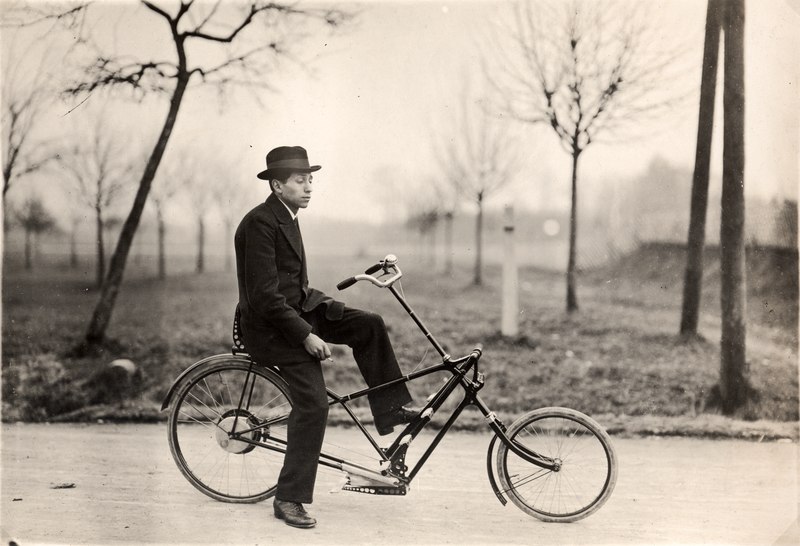The fellow in the photo is Paul Jaray, the noted and very influential early aerodynamicist (Zeppelin airships, cars, his Tatra influencing Ferdinand Porsche's Volk's Wagen), in 1921 aboard a bicycle of his own design and construction.

Paul Jaray on his J-Rad, 1921. Photo in public domain.
I haven't the faintest idea of how the thing worked, but we can note a few points:
Jaray didn't believe in contorting the human body to fit aerodynamic theories. He sits bolt upright on his bike with a very short virtual top tube and the handlebars reachable with upper arms perpendicular to the ground, then thought to be an ergonomic position.
Finally, and the point of this post: Was that large hublike object at the centre of the rear wheel a forebear of the Rohloff Speed 14? Or even an automatic version of some perpetual motion machine? I imagine the pedals were operated by heel-and-toeing on the two bright objects seen on the downtube, and that on the far side his raised foot rests on them. Hell on the hamstrings, is what I think. Otherwise, the only method of propulsion I can see are his feet running along the road -- and even I don't believe it.
More, where's the connection between his feet on the supposed pedal and the rear wheel? There's no transmission of power visible. There is some kind of construction in front of the head tube which may be a pivot, with a matching apparent pivot under the "bottom bracket", but that would make the bicycle essentially bottom-tubeless, which I cannot believe either: Jaray was a distinguished graduate of a tough engineering school, chosen by a famous engineering teacher to be his assistant. The other possibility is that the drive is inside the tube, but the conrods would have to be very thin and there doesn't seem to be anything at end of the chainless chainstay big enough to be a right-angle turn for the transmission.
Still not the end of the mysteries. At first glance I took the short strut under the joint of seat and bottom tubes and chainstays (let's be inventive and call it a bottom bracket) to be a flip stand for pulling the bike over and resting it, but on closer inspection I'm less sure. Maybe that is part of the transmission. Or perhaps there is no chainstay at all, and that entire construction starting at his feet and going forward to in front of the head tune, and returning to the assembly under the bottom bracket is the transmission to the "chainstay" which somehow acts as the connecting rod. The downtube of the semi-mixte configuration seems sturdy enough to support this interpretation.